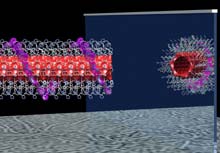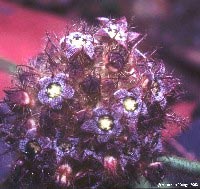Articles and reports from the Life Sciences and chemistry area deal with applied and basic research into modern biology, chemistry and human medicine.
Valuable information can be found on a range of life sciences fields including bacteriology, biochemistry, bionics, bioinformatics, biophysics, biotechnology, genetics, geobotany, human biology, marine biology, microbiology, molecular biology, cellular biology, zoology, bioinorganic chemistry, microchemistry and environmental chemistry.

Nanotubes, stringy supermolecules already used to create fuel cell batteries and tiny computer circuits, could find myriad new applications ranging from disease treatment to plastics manufacturing to information storage, reports a Purdue University research team.
Scientists led by Purdue chemist Hicham Fenniri have learned to create multiple species of nanotubes that possess unprecedented physical and chemical properties, each of which could lead to a different industrial application. Also

Two independent research groups, led by Drs. Haruhiko Siomi (Institute for Genome Research, University of Tokushima, Japan) and Gregory Hannon (Cold Spring Harbor Laboratory, USA) have discovered that the Drosophila version of the human fragile X mental retardation protein associates with components of the RNAi pathway, suggesting that the molecular mechanism underlying fragile X syndrome may involve an RNAi-related process.
“It has been our feeling since we became involved in the field sev

The c-myc gene is commonly activated in a variety of human tumors. As a new report in the October 1 issue of Genes & Development shows, scientists are gaining a better understanding as to why.
Dr. John Cleveland and colleagues at St. Jude Children’s Research Hospital have discovered that c-Myc is essential for tumor development, as it regulates factors necessary for the growth of blood vessels into tumors – lending a new potential target to anti-angiogenic cancer therapies.
T

Speaking at BioArrays Europe (Cambridge, UK, 30 Sept-1 Oct), Dr Tony Smith, Chief Technology Officer (CTO) of Solexa, presented data on the progress of the Company`s proprietary Single Molecule Array™ technology for human genetic variation applications, highlighting significant progress in the massively parallel detection of single molecules using fluorescence.
Solexa’s Single Molecule Array technology is being applied to the measurement of individual genetic variation to develop a method f

Less than 10% of the human genome contains coded information in the form of genes. The 30,000-40,000 genes in the genome are found grouped in discrete regions of the chromosomes. Chemical agents and radiation habitually cause a large variety of injuries to the DNA which interferes in many cell processes, like transcription and replication, and this can cause a loss of control of cell division and the appearance of tumours. In order to avoid this, the human genome contains more than 130 DNA repair gen

A new species of climbing milkweed has been named by Alexander Krings, curator of the North Carolina State University Herbarium (also NCSC, its international Index Herbariorum abbreviation). The species – Gonolobus tenuisepalus Krings – was first collected in the tropical rainforests of southern Costa Rica while Krings was a graduate student in the Department of Forestry.
“The flowers are tiny (about 6-8 millimeters in diameter), purplish to dark brownish-red and borne in